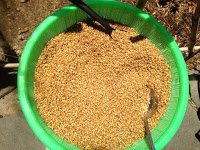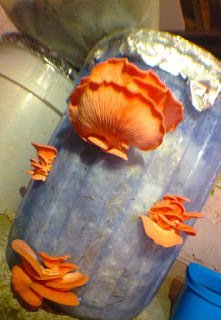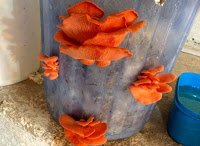Fungi Academy - Mushrooms in the Lab

Here is the lab. In the cabinets above you can see all sorts of interesting things growing and being stored in a variety of ways. The newest addition is the wall painting by Raquell Yang.
Let's now try to go over how to cultivate mycelium and mushrooms in a rudimentary laboratory. You can fairly easily clone, expand colonies, grow and spread mushrooms by taking spore samples or cuttings from mushrooms you find or buy. You can also buy grow kits and order spores online that's not as fun now is it?

You can take tissue or spore samples from most mushrooms you come across and give them a chance to feed, grow and expand on a variety of growing mediums like wheat, straw, coffee grounds, hardwood logs and more. For now, let's go over how to grow and expand your sample in a Petri dish filled with a nutritious growing medium shown below. The best food source for your mushrooms varies from species to species with some eating just about anything and others being much more picky. We are going to start off with Oyster Mushrooms which are super easy to grow, are found all over the world, are delicious themselves and they consume just about every growing medium imaginable.

To take a spore sample cut off the top and put the cap on a piece of paper for an hour. This method however has a high risk of contamination. For tissue samples just cut the mushroom open around the root and take a clean flesh sample from inside. This also has a risk of contamination which takes us to the next lesson - mindful practice of sterilization.
Allowing the fungi to consume food and grow uninterrupted can sometimes be tricky. Any kind of nutrition is constantly being fought over with other organisms. In this case, any microscopic spores or bits of bacteria which are constantly floating in the air all around us can contaminate your desired fungi's source of nutrition thus creating a battle for food. Ideally you want to give your favoured side the best conditions for winning and not allowing any others a chance by handling all transfers in a sterile environment. When contamination occurs there are some cases where your fungi is a strong and hardy enough strain to win but most of the time it is not and a mouldy bacteria takes over and needs to be disposed. There is a chance to cut out a healthy, uncontaminated bit and transfer it to a new growing medium but risk of contamination is high. Below you can see the white healthy mycelium fighting with black mould.

You can fairly easily create a contained lab box out of a large sealable plastic tub and some gloves. A spray bottle of diluted alcohol and hydrogen peroxide are your friends. Everything inside and out of the box is sterilized before handling. Mindful care must be taken to keep everything inside the clean zone. In the lab here we are fortunate enough to have home made hepa filter clean air blowing units. Still though, there is only a small area of sterilized space within which to work. Anything leaving that area must be cleaned again.




Above we're scraping spore samples onto a Petri dish. The same would be done with a tissue cutting. When the mycelium grows uninterrupted on the dish you can take out pieces to store for future use. Remember, mycelium always like to keep running so its best to transfer it to larger growing mediums when its still moving rather than when it's consumed all the food available and starts to slow down it's expansion.
After the mycelium starts showing healthy signs of uncontaminated growth you can then consider how you want to expand the colony. Remember to always think about what other things your fungi might be competing with so learning how to pasteurize, sterilize and prepare uncontaminated growing mediums is a must. Here we take grains and soak them in water for 24 hours then cook them half way through. After, we put them in jars and steam them in a pressure cooker for 2 hours. The condensed steam produces a temperature above boiling point which kills just about everything.



After a sterile growing medium is ready you can inoculate it by taking a cutting from your petri dish sample. Again, be aware and keep sterile. Here we are injecting the grain bottle with hydrogen peroxide before we put our sample in there.

Below you can see a variety of different species growing mostly on grains which work well for the next stage which involves spreading the inoculated grains over another growing medium from which the mushrooms will be able to fruit.



Here are the inoculated grains being spread over some pasteurized horse poop in a little grow box with holes cut in and stuffed with cotton for air exchange with less risk of other spores or flies getting inside. The grains break up nicely and spread evenly allowing for a nice little poop and mycelium lasagna.


After that simply store in a cool damp place and wait for mushrooms to pop out.
Ok, after going over all that lab stuff I realize it all might be a bit intimidating to try to start this on your own. So lets go over some super easy ways to grow and expand mushroom colonies.
Take some old egg cartons or cardboard, soak them in water and hydrogen peroxide at about a 9-1 ratio. Break up some of the lower parts of the stem and roots of a mushroom and put them on the sterilized paper product, pop them in a sealed bag, store in a temperate area, wait for mycelium to start expanding, open the bag, break apart the pieces into a garden with soil and wood chips, water every day for 2 weeks and then let nature take its course. Depending on the variety you could have mushrooms fruiting in 2-4 months. Remember to look at which varieties share nutrients and energy with garden plants and which ones do better on their own. Here we are propagating King Strofaria otherwise know as Garden Giant which is a wonderful companion to most plants and trees.



Here we are inoculating fresh cut hardwood logs with little wooden dowels and sawdust we grew mycelium on in the lab.


Drill holes in the wood, stuff it with mycelium, seal with bees wax, store them in a damp place or put them in a shaded garden area and cover with soil. All of these techniques should be started in the early spring with lots of rain and moisture, followed by an incubation and colonization period over summer and fruiting period in fall when the weather cools.

Grow bags are another great option for fast and easy to pick mushroom growing. Fill a plastic back or bucket with the desired growing medium, add your mycelium in layers, seal the bag or buck, cut or drill some holes in the bag and cover them with microporous tape, store in a temperate place. Mushrooms for dinner in a few weeks if all goes well.




There are a ton of websites and books that have all sorts of different growing ideas and tips as well as neat designs the incorporate mushrooms into gardens provide a number of enhancements with fresh mushrooms being an awesome bonus.
I can recommend mycotopia.net which is a online community ready to answer all your questions.
Here is shroomery.org for mental medicinal mushroom tips.
For classification, mushroomobserver.com is great.
Checking out one of these books is also an awesome way to get your head wrapped around growing mushrooms. I especially recommend 'Organic Mushroom Farming and Mycoremediation' for any newbie like myself and 'Mycelium Running' if you want your mind blown by the incredible power of mushrooms.
